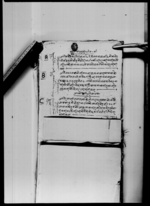A copy of a lālamohara from King Gīrvāṇayuddha appointing priests of Manakāmanā (VS 1864)
ID: K_0029_0025B
Edited and
translated by Astrid Zotter
Created: 2017-08-15;
Last modified: 2018-06-04
For the metadata of the document, click here
The accompanying edition, translation/synopsis and/or commentary are available under the terms of the Creative Commons Attribution-ShareAlike 4.0 International License
Abstract
This document addresses Śrīkṛṣṇa and Ranyā Thāpā, descendants of Lakhana Thāpā, and appoints them to look after the guṭhī dedicated to the daily worship of Manakāmanā.Diplomatic edition
[1r]
1३६नं1जैसीकोठाअडावाट2सकलवमोजिंनकलदुरुस्तछ1आगेलषनठापाकोसंतानश्रीकृष्णथापारन्याथापाके
2नव़लसींवाडाकोषाये़लनीत्येश्रीमनकामनाकापुजा•
3कफ्याकगाउ•गुठ्षेत•२।तस्कोलगापातछापनेवारमा
4थीकोचौधरी•मेतीवकसीऊआफनाषातीरज्मासीत•
5गुठ्जानीभोग्येगरइतीमीतिसडर•------------------------१
Translation
[1r]
No. 361
From the Jaisīkoṭhā office:
The copy is true to the original.
Āge: to Śrīkṛṣṇa Thāpā and Ranyā Thāpā2 , descendents of Lakhana Ṭhāpā.
We have erased (metī for meṭi)3 Navala Sīṃ Bāḍā’s [claim to] holdings (khāyela), [along with the right to perform] the daily worship of Śrī Manakāmanā, the guṭh of Kaphyāka Gāu [comprising] 2 | khetas and their surrounding land (lagāpāta) as a chāpa [and] authority (caudharī) over the Newars. Consider the guṭh [yours] and enjoy it, mindful of your duty.
Whereafter [a notation of] the date4 [and the place dispatched from,] the capital.
Commentary
The document is a transfer of entitlements previously granted to Navala Sīṃ Bāḍā to the descendants of Lakhana Thāpā.
There seems to have been a rotation of the office of pūjārī of the Manakāmanā temple between two parties, the descendants of Lakhana Thāpā (the legendary Magar saint and founder of the shrine) and Newar Buddhist Bāḍās. Four documents similar to the present one but issued later have been published in transcription by G. Unbescheid (1985: 127–129). They more or less follow the phrasing of the present document, the oldest known so far, but expand the details (e.g. calling the appointment that of a pūjārī—pūjāhārī baksyaũ—in all documents) and adding more entitlements. They were issued between VS 1871 and 1877 and are addressed either to the descendants of Lakhana Thāpā (in VS 1871 and 1877; docs. I, VI)—while always, as in the present case, mentioning Navala Sīṃ Bāṛā—or to Navala Sīṃ Bāṛā alone (in VS 1872 and 1875, docs. II and IV). Unbescheid (1985: 118–123) also interprets the documents as relating to these two groups of priests, but he does not discuss this in detail. His study of the context in question corroborates the continuity of a shared priesthood between Magar and Newar Buddhist priests.

